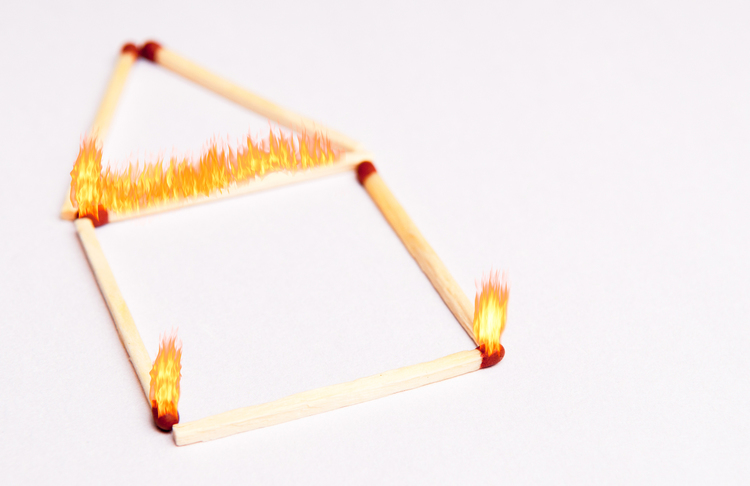
As the weather turns colder, we look to stay warmer and naturally spend more time indoors in the comfort of our homes. Household fires can start for a variety of reasons - but in most cases, with a little more attention, are entirely preventable. Here's a list (Courtesy of the Reader's Digest of Canada) of the Top 10 Causes of Home Fires and what you can do to prevent them from ever occurring in your household.
1. Cooking Equipment - Oftentimes, it's not the equipment that causes the fire, it's the inattention of what's going on with using it. When a pot or a pan overheats or splatters grease, a fire can erupt in the blink of any eye. Always stay in the kitchen when cooking, especially if using oil or high temperatures. And keep combustibles like oven mitts, dish towels or paper towels away from heat sources. It's also important to keep your oven and gas burners clean and grease free.
As for microwaves, there are all sorts of items that should never see the inside of yours - items containing metal (like Chinese takeout containers), lunch bags, plastic containers for items like yogurt or margarine, most travel mugs, aluminum foil, styrofoam containers, eggs, fruit, hot peppers, plastic storage containers, travel mugs and wet clothing. If in doubt, leave it out - and make sure food items that could potentially splatter are covered with microwave safe lids or microwaveable paper covers. And finally, don't ever turn your microwave on with nothing in it - the microwave needs something to absorb its energy and when there's nothing there, the microwave absorbs its own energy which can cause it to blow up and catch fire.
2. Heating Equipment - By now you've probably turned on your furnace - but have you had it inspected by a qualified technician? You should also have your chimney cleaned and inspected annually. If you use portable heaters, keep them at least three feet away from anything that can burn (including curtains, furniture, and you), and don’t use your heaters to dry shoes or clothes. If you haven't already, install a carbon monoxide alarm to alert you to deadly carbon monoxide gas.
3. Careless Smoking - If you're going to allow smoking in your home, at least be aware of the cautions you need to take. Make the bedroom off-limits to smoking, and supervise smokers who may become drowsy (i.e. on medication, drinking) or forget to extinguish their cigarette. Use large, deep ashtrays; never place an ashtray on or near anything that will burn and when emptying, make sure everything has been extinguished. Before each night is done, check furniture for fallen cigarettes/embers (a butt can smolder for hours before causing furniture to burst into flames).
4. Electrical Equipment - Faulty electrical equipment is often the cause of home fires. Here are a few items you can do a quick check in each room to make sure it doesn't happen in your household. Make sure ...
- Your electrical appliances don’t have loose or frayed cords/plugs
- Your outlets aren’t overloaded with plugs
- You’re not running electrical wires under rugs or heavy furniture
- You’re not overusing an extension cord
- Be careful about do-it-yourself electrical projects; many home fires are caused by improper installation, so use a licensed electrician
5. Candles - Keep candles in a sturdy holder on a level surface, away from combustible materials and out of the reach of children or pets. Blow them out before leaving the room.
6. Children playing with fire - Children cause fires out of curiosity (what happens when something burns) or mischief (they’re angry, upset or destructive, and fire is a major taboo to break). Kids may be involved in fire play if you find matches or lighters in their room/possession, smell sulphur in their room, and/or find toys or other personal effects that appear melted/singed.
7. Poor Wiring - Older homes sometimes have inadequate wiring—which can become a fire and an electrical hazard. Some warning signs:
- You have to disconnect one appliance to plug in another
- You have to use extension cords or “octopus” outlets extensively
- Fuses blow or circuit breakers trip frequently
- Lights dim when you use another appliance
8. Flammable Liquids - Items like fuels, solvents, cleaning agents, thinners, adhesives, paints, and other raw materials can ignite or explode if stored improperly. The vapors can easily ignite from even just high temperatures or weak ignition sources (one spark of static electricity). Don’t store flammable liquids near a heating source. Ideally, keep them outside of your home in a cool ventilated area, in approved containers.
9. Christmas Trees and Decorations - Keep real trees in a stand that holds water, and top it up daily. Keep the tree away from all heat sources, including radiators, furnace ducts, television sets and fireplaces. Check decorative lights before placing them on the tree, and discard any frayed or damaged lights/cords. Never place candles on or near the Christmas tree.
10. Barbeque pits - It's amazing how many house fires begin as a result of barbeque pits. Some people still want to barbeque when the weather gets colder - so they bring the pit into the garage or under an overhang of the house. That's a bad idea as flames or embers can easily lead to an unexpected fire. If your barbeque pit uses propane, spray the connections with soapy water to check for potential leaks; watch if bubbles form when you open the gas. When storing your pit for the winter, make sure to disconnect the propane and store in a cool area, away from any heat sources.
